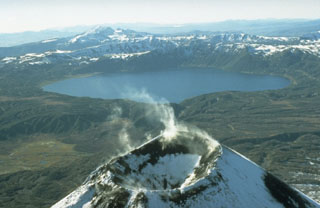Report on Akademia Nauk (Russia) — January 1996
Bulletin of the Global Volcanism Network, vol. 21, no. 1 (January 1996)
Managing Editor: Richard Wunderman.
Akademia Nauk (Russia) Explosive eruption from Karymsky Lake and new crater at summit
Please cite this report as:
Global Volcanism Program, 1996. Report on Akademia Nauk (Russia) (Wunderman, R., ed.). Bulletin of the Global Volcanism Network, 21:1. Smithsonian Institution. https://doi.org/10.5479/si.GVP.BGVN199601-300125
Akademia Nauk
Russia
53.98°N, 159.45°E; summit elev. 1180 m
All times are local (unless otherwise noted)
Periods of seismic unrest have occurred several times in the past 12 months, including one episode in April 1995 (BGVN 19:05), and the volcano usually emits a continuous steam plume. Based on recorded seismic activity, an eruption apparently began during 1700-1900 on 1 January. Russian aviation sources reported an ash plume to 7 km altitude at approximately 1130 the next day. A satellite image at 1400 on 2 January showed that the plume had extended at least 200 km SE and S of the volcano. Several aviation notices (SIGMETs) were issued concerning the ash plume. GMS satellite imagery revealed multiple ash emissions on 2 January, with the cloud height estimated at ~7 km. Satellite data on 3 January continued to show multiple low-level (below 5,400 m) ash bursts of short duration that drifted S and dissipated within an hour.
When the volcano was visited by Vladimir Kirianov and Yuri Doubik of the Institute of Volcanic Geology and Geochemistry between 1330 and 1630 on 3 January, they discovered that the initial eruption had vented from the N end of Karymsky Lake. The lake occupies the 5-km-diameter late-Pleistocene Akademia Nauk caldera, ~5 km S of Karymsky volcano proper. However, by the time of their visit activity had shifted to Karymsky volcano where a new crater had formed on the SSW side of the summit, adjacent to the old crater. The new crater, approximately the same size as the old crater, produced explosions every 1-5 minutes that fed a thick black ash plume to an altitude of ~2.5 km moving E. Fresh ashfall was widespread throughout the 5-km-wide Karymsky caldera and for a considerable area to the E and N. Karymsky Lake was yellow-gray in color and mostly covered by steam and vapor. The Karymsky River, which drains the lake to the N, was completely buried in ash and no longer visible; a new beach with numerous fumaroles marked the former source of the river. Very strong seismic activity associated with the eruption included one M 6.5 earthquake on the first day of the eruption. Seismic stations as far as 110 km from the volcano recorded the activity.
By 5 January the new summit crater was over twice the size of the old crater. A thick black ash plume had been observed the previous two days erupting explosively from the new crater to altitudes ranging of 2,400-5,500 m. Seismicity on 6 January indicated continued explosions every 1-3 minutes. Karymsky Lake remained yellow-gray and covered by steam and vapor. Seismicity through 12 January was interpreted to reflect continued, but less explosive, eruptive activity.
Karymsky, ~110 km NW of Petropavlovsk-Kamchatsky, is the most active volcano of eastern Kamchatka. The latest eruptive period began ~500 years ago; much of the cone is mantled by lava flows less than 200 years old. It has been quiescent since frequent eruptive activity during 1970-82. The volcano is capable of explosive eruptions which can send ash to over 10 km and continue sporadically for days or weeks; short lava flows are also common.
Geological Summary. The lake-filled Akademia Nauk caldera is one of three volcanoes constructed within the mid-Pleistocene, 15-km-wide Polovinka caldera. The eroded Beliankin stratovolcano, in the SW part of Polovinka caldera, has been active in postglacial time (Sviatlovsky, 1959). Two nested calderas, 5 x 4 km Odnoboky and 3 x 5 km Akademia Nauk (also known as Karymsky Lake or Academii Nauk), were formed during the late Pleistocene, the latter about 30,000 years ago. Eruptive products varied from initial basaltic-andesite lava flows to late-stage rhyodacitic lava domes. Two maars, Akademia Nauk and Karymsky, subsequently formed at the southern and northern margins of the caldera lake, respectively. The northern maar, Karymsky, erupted about 6,500 radiocarbon years ago and formed a small bay. The first recorded eruption from Akademia Nauk took place on 2 January 1996, when a day-long explosive eruption of unusual basaltic and rhyolitic composition occurred from vents beneath the NNW part of the caldera lake near Karymsky maar.
Information Contacts: Tom Miller, Alaska Volcano Observatory (AVO), a cooperative program of a) U.S. Geological Survey, 4200 University Drive, Anchorage, AK 99508-4667, USA, b) Geophysical Institute, University of Alaska, PO Box 757320, Fairbanks, AK 99775-7320, USA, and c) Alaska Division of Geological & Geophysical Surveys, 794 University Ave., Suite 200, Fairbanks, AK 99709, USA; Vladimir Kirianov and Yuri Doubik, Institute of Volcanic Geology and Geochemistry, Piip Ave. 9, Petropavlovsk-Kamchatsky, 683006, Russia; NOAA/NESDIS Synoptic Analysis Branch (SAB) , Room 401, 5200 Auth Road, Camp Springs, MD 20746, USA.

